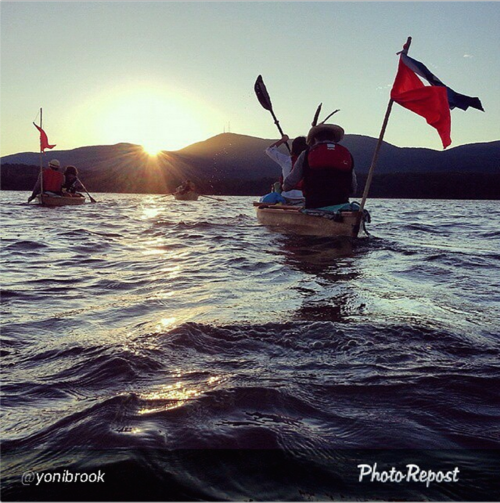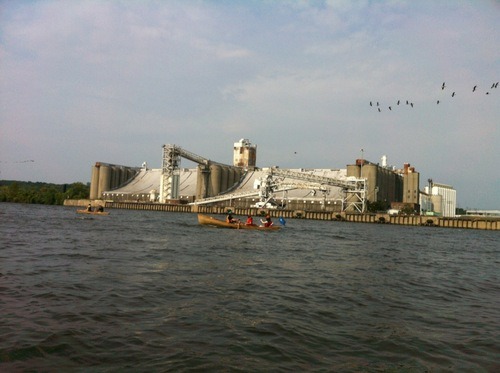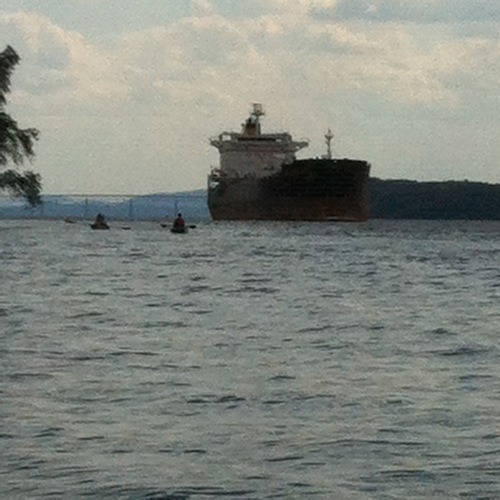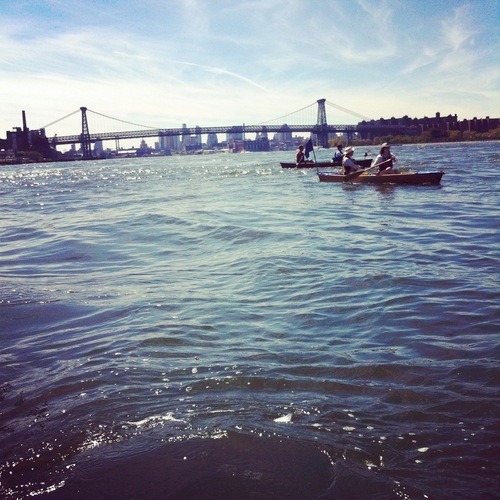For the first two weeks of September, a flotilla of handmade paper canoes journeyed the improbable waters of the Hudson River from Troy to Manhattan, weaving stories of resistance and resilience on a voyage to the People’s Climate March. The flotilla’s journey wove together many distinct stories of local environmental threats in the context of a common and looming global crisis. Our paper canoes sit low in the water – you feel each wave like a new land rising beneath you, pulling you up and into some improbable future.

We are in the untold times. Some of our species has managed to rocket the planet out of the geologic age we were born into, and to create our own: It is time to create new mythologies for the Anthropocene. For the first two weeks of September, a flotilla of handmade paper canoes journeyed the improbable waters of the Hudson River from Troy to Manhattan, weaving stories of resistance and resilience on a voyage to the People’s Climate March. The flotilla’s journey wove together many distinct stories of local environmental threats in the context of a common and looming global crisis.
As a generation with the mixed fortunes of being alive in an age with both cheap weekend flight packages and rising sea levels, we have no choice but to embrace the improbability of this moment. We are in a tiny window of opportunity within which we can determine if the climate crisis will be merely a major crisis or a complete catastrophe for our planet. This is an improbable situation, and many move straight from denial to hopelessness; but it is not an impossible situation. We must inhabit that sliver of hope, and enact stories inside it.
The past two weeks I have lived this improbable paper story, voyaging the two-water waters of the Hudson River with a band of fellow dreamers. By enacting the dream – we awoke, and saw the magnitude of both the beauty and the danger that surrounds us. We saw the mist that rises over the river at sunrise and the steam that rose from Indian Point’s cooling tower; we heard the sound of a stork’s wings flapping above our heads and the warning whistle of the explosive train-units as they hurtle past intersections; we learned the surface of the water and its depths. I have returned from this journey with a new sense of scale of the danger and an understanding of the depths of what might be lost. In New York we are gambling our entire River: high stakes for another decade of living a dying American dream.
Our route began in Troy – chosen for its forgotten history of paper boat making rather than its name’s epic connotations. Quickly we realized we were inadvertently following the exact route of Global Partners’s proposed “virtual pipeline” that uses a series of trains, barges and trucks to bring crude oil from the Bakken fields of North Dakota through Albany and Newburgh, and down to the New York Metropolitan area. Currently and stealthily, this trickle of oil is flooding along the river: 40 times more crude oil is already being transported down the Hudson than it was four years ago. New proposals have been filed for new heating centers that would allow crude oil and tar sands from Alberta to be processed in Newburgh and Albany, then loaded onto barges and sent downstream. “The problem we’re facing is that with the tremendous and increasing volume of crude oil being transported throughout the Hudson Valley, a spill is inevitable” says Kate Hudson of Riverkeeper. An oil tanker has already run aground in December 2012, carrying about as much oil as spilled in the Exxon Valdez disaster, and New York State has seen at least four derailments in the span of just three months. A spill anywhere along this “virtual pipeline” would mean disaster for the river, what doesn’t spill and is burned means disaster for our climate. We are being bribed into a lose-lose situation.

Our very first day of the journey, local organizers in Albany showed us where the long black trains are parked – just yards from housing apartments and playgrounds. Railway workers call these the “Bomb Trains”, because the railcars become pressurized along their journey, becoming volatile and explosive. An explosion in Albany, the like the one in Lac Megantic in 2013, could mean up to 5,000 dead. A retired MetroNorth worker told us such a disaster was only a matter of time, that these were time bombs running along an underfunded and rotting rail infrastructure – an accident waiting to happen. Every night of our journey we camped along side of the river, we were always within range. Many people live with this illegal (for the railcars aren’t rated to take pressurized contents) menace. A rupture in one railcar could set off a chain-reaction across the railcars, could spill into the river, could set the river on fire for days. Our entire watershed could become a casualty to Global Partners’ bottom line.
I shudder to think of a spill: crude oil sinking to where the massive sturgeon feed on the bottom of the river, or the lighter Bakken Crude floating to the top with the herons and lilies bathe in moonlight, and where we swam. In minutes, a spill could erase the decades of devotion that is returning health to the Hudson – a sticky layer of flames pushed to and fro by the river’s two-way tides, the river boiling under a blanket of death. This could happen at any moment. Why do we play this game if the stakes are so high? 250,000 people’s drinking water comes from the Hudson – water is a right, not a privilege; it is the ecological ground for all life, not an unregulated highway for corporate profits. Each day of our journey I fell deeper in love with the beauty of this river-that-flows-both-ways; to risk it seems unbearable.

At night the Aphrodite oil barge, like some ominous pendulum, with 9.6 million barrels of crude in her belly, swings up and down the river at regular intervals, just part of the 25 million gallons of oil that is already making its way down the Hudson River each week. Its name – “Aphrodite”: goddess of love, beauty, pleasure, and procreation – scared us in its irony, just as the names of the proposed fracked gas pipelines that cross the Hudson: Algonquin, Iroquois, Pilgrim. The imperialism of greed threatens to reclaim even our past.
Towards the end of the journey, we caught an evening glimpse of Manhattan, its lights shone in the distance like a cubist landscape even from well before the Tappan Zee Bridge; for three days we quietly approached it – the buildings growing slowly in scale until they towered over our small boats. Early on, our journey had adopted the motto: “We All Live Downstream”,acknowledging that all of our waters are connected – they circulate, infiltrate, rain, freeze and flow throughout the ages. What we do to the water, we do to ourselves. Our arrival in Manhattan localized this adage – here we saw not only a city perched on the end of a river, but also a city at the end of a massive and hidden infrastructure. What had been invisible was suddenly all around us. The grandiose immortality of this “city that never sleeps” requires a revising when you have seen the risks required to keep it lit-up and zooming down the avenues. It no longer seems like some autonomous beast, rather an aging boiler that requires constant fueling; a city that has enslaved us to its own designed addictions. Inside the glass buildings, there are businessmen taking grave gambles with things that do not belong to them, raking in rewards but taking none of the risk. They move money to stoke the fires to keep this city from sleeping, but I remember what Sandy did to this city-that-never-sleeps when it opened New York’s skies to the stars again.

On our last day, we paddled quietly down the West Side of the island of Manhattan, watching trees grow into skyscrapers and back down again to humbler brick buildings. As we passed you could see up the streets far into the heart of the city, at 42nd street the neon glow of Times Square blared out even along the water. I wondered what is burned to make the electricity to keep those vital advertisements illuminated. The current whisked us quickly by.
The skyscrapers seem minuscule when you know the size of this ribbon of river that flows the length of our two week journey. We had begun to measure distances in days, and this city is only a day to paddle around. From the water, New York City doesn’t seem so invincible. It hangs low, inviting a brave wave to take a shortcut from the East River across to the brackish Hudson. I had seen the whole downtown darkened by such waters only two years ago – despite the great height of our buildings we will not be able to escape into the sky.
The tasks our generations currently face should not be underestimated, as the organizers of the People’s Climate March state – to change everything it takes everyone. We know this world is changing – chemically, politically, economically, socially, physically – how we react to those changes is the only thing we still control.
If you pay close attention on a tidal river, there are moments when you can feel the sea change beneath you. A split second when the river hovers, unmoving, neither ebbing nor flowing. Your boat lingers in a moment, but only for a moment. By the next time your paddle hits the water everything is in motion again, slowly at first, but surely. We are all in this pivotal moment as a global community. Whether we decide to push on against the current that is flowing increasingly against us, or we change course and let the wise currents pull us easily into the future that wants to be.

—-
Many others are part of this story:
Many of the group involved in the SeaChange Voyage will also be joining together on Monday September 22nd for #FloodWallStreet, a direct action aimed at the economic causes of the ecological crisis.
You can tell our government what you think about crude oil transport on the Hudson here.
We only have until September 30th to submit public comments. If we get enough support on this, we could stop this project before it gets out of control.
For more on the SeaChange Voyage visit www.seachange2014.tumblr.com